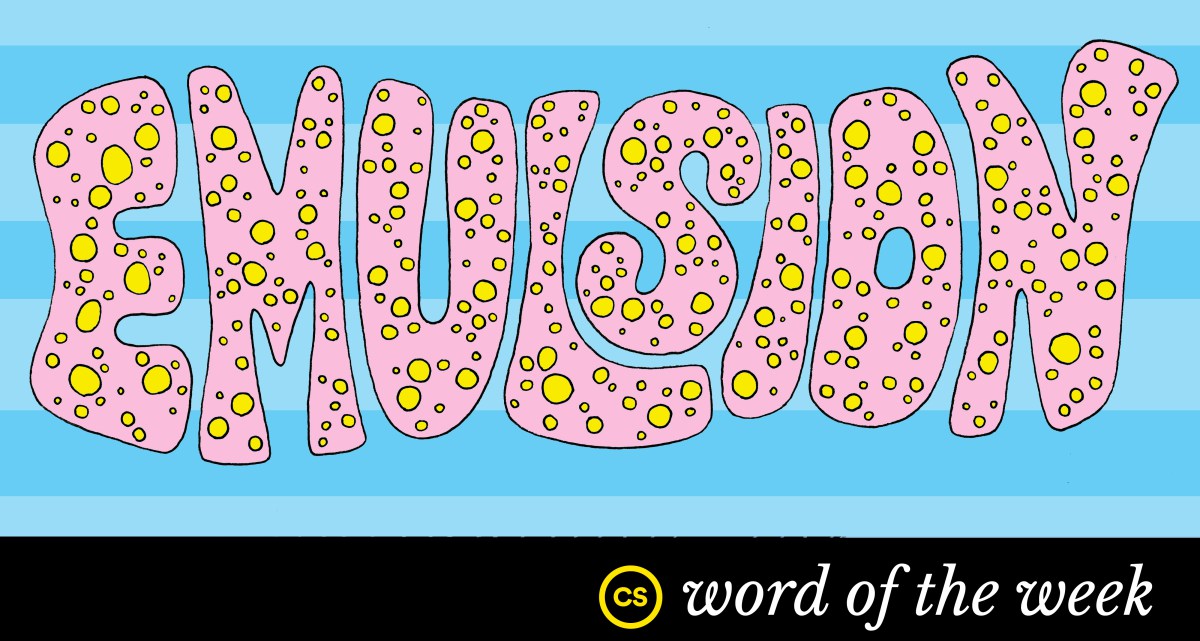Working at the intersection of food and science, we come across a LOT of scientific jargon and terminology, from chemical processes (see: nixtamalization), to physical phenomena (see: non-Newtonian fluids), to species names (see: Aspergillus oryzae). We’ll be sharing many of these fun words with you in this ongoing series, the Cook’s Science Word of the Week. Get ready to impress at your next cocktail party.
Oil and water don’t mix. It’s a truism we learn in elementary school. “Like girls and boys in the lunchroom,” the teacher said.
Why don’t they mix? They’re different kinds of molecules. Each molecule of water has two ends, one with a positive charge and one with a negative charge, and, just like in magnets, the opposite poles attract each other. Water molecules cling together, with the positive pole of one water molecule sticking to the negative pole of the next. Water also clings to other kinds of molecules that have charged poles, like salt or alcohol, forming a solution.
But oil molecules have no positive or negative charge—they are non-polar—and so water is indifferent to them. The two kinds of molecules have no way to cling together, so they stay in their separate areas, like middle schoolers at a dance.
If you have a blender, or a good whisking arm, you can get them to play nice for a while. Forcibly whipping oil and water together will break the oil up into little droplets, which aren’t individually buoyant enough to push through the water and form a separate layer again. Or at least, it takes them a little longer to do so: long enough to pour a shaken vinaigrette onto a salad, but not long enough to store it in the fridge without needing to shake it up again next time.
This is an emulsion: a mixture in which small drops of one substance are dispersed throughout another substance. But how can we keep it from coming apart after a few minutes? An emulsifier.
Emulsifiers are like kids who are friendly with the girls’ clique and the boys’ clique. A common example is lecithin, which is found in egg yolks, soybeans, and other sources. It’s a large molecule with one part that’s attracted to oil, and another part that’s attracted to water. So when it’s mixed in with oil and water, a lecithin molecule grabs on to an oil droplet with its fat-loving end, and with its water-loving part facing the water. With the emulsifier encouraging them to intermingle, an emulsion can stay stable for a much longer time. It’s still made out of oil droplets dispersed in water, but the emulsifying molecules attached to each oil droplet let the droplets stay cozily mingled with the water instead of rising to the top.
That’s why there’s egg yolk in mayonnaise—the lecithin in the yolk emulsifies the oil and the vinegar together. (For emulsion purposes, vinegar is basically water.) Milk is an emulsion too, with droplets of butterfat dispersed throughout a watery medium. So are cheese, ice cream, tahini sauce. Even hot dogs: during manufacturing, the finely ground meat smoothly emulsifies fat into water inside the dog.
When oil and water are emulsified together, the emulsion has different properties than either of its components. Mayonnaise is thicker and creamier than either oil or water because, in order for it to flow, the water and the oil droplets have to slow down and move around each other, instead of pouring smoothly like either ingredient can when it’s on its own.
Its emulsion nature is also why mayonnaise is opaquer than oil or water: Even though the oil droplets are tiny (about 10 micrometers in diameter), there are millions of them, and light bounces off their surfaces, rather than passing through as it does in pure oil or water. Some industrially produced nanoemulsions have much smaller droplets—just a few billionths of a meter in diameter—which is too small to reflect light, so the emulsion appears transparent. Many citrus sodas, for instance, contain nano-emulsified essential oils.
Mayonnaise is an example of an oil-in-water emulsion: oil droplets are dispersed in water, which is the “continuous phase.” Oil-in-water is the most common kind of emulsion in the kitchen—milk, ice cream, cheese, the finely ground meat in hot dogs, and tahini sauce are all examples—but it’s not the only kind. Butter is a water-in-oil emulsion: its fat content is so high that it forms the continuous phase, and droplets of water are dispersed through it. So is peanut butter.
So you see, kids, many of the most delicious foods can only happen when different types of substances work together. What do you think about that?
Is there a word you wonder about? Email us!
Graphics by Sophie Greenspan



